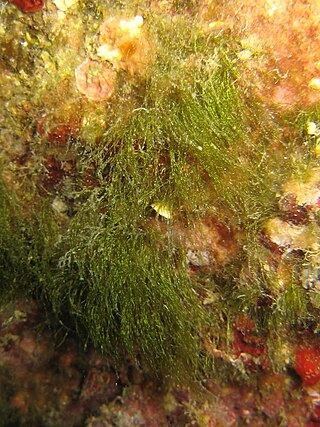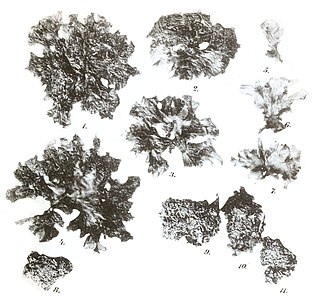
Ulva is a small island in the Inner Hebrides of Scotland, off the west coast of Mull. It is separated from Mull by a narrow strait, and connected to the neighbouring island of Gometra by a bridge. Much of the island is formed from Cenozoic basalt rocks, which are formed into columns in places.

The sea lettuces comprise the genus Ulva, a group of edible green algae that is widely distributed along the coasts of the world's oceans. The type species within the genus Ulva is Ulva lactuca, lactuca being Latin for "lettuce". The genus also includes the species previously classified under the genus Enteromorpha, the former members of which are known under the common name green nori.

Green laver, known as aonori in Japan, sea cabbage (海白菜) or hutai (滸苔) in China, and parae (파래) in Korean, is a type of edible green seaweed, including species from the genera Monostroma and Ulva. It is commercially cultivated in some bay areas in Japan, Korea, and Taiwan, such as Ise Bay. It is rich in minerals such as calcium, magnesium, lithium, vitamins, and amino acids such as methionine. It is also called aosa in some places in Japan.

Ulva lactuca, also known by the common name sea lettuce, is an edible green alga in the family Ulvaceae. It is the type species of the genus Ulva. A synonym is U. fenestrata, referring to its "windowed" or "holed" appearance, Despite the name, it is not a lettuce

Saint-Michel-en-Grève is a commune in the Côtes-d'Armor department of Brittany in northwestern France.

Ulva intestinalis is a green alga in the family Ulvaceae, known by the common names sea lettuce, green bait weed, gutweed, and grass kelp. Until they were reclassified by genetic work completed in the early 2000s, the tubular members of the sea lettuce genus Ulva were placed in the genus Enteromorpha.

Ulva linza is a green alga in the family Ulvaceae that can be found in British Isles.
Ulva anandii is a species of seaweed in Ulvaceae family that can be found in Buleji and Karachi districts of Pakistan.
Ulva acanthophora is a species of benthic subtropical seaweed in the Ulvaceae family that can be found in California and Mexico.
Ulva atroviridis is a species of blackish-green coloured seaweed in the family Ulvaceae that can be found in Port Nolloth of Cape Province in South Africa and in Namibia.

Ulva chaetomorphoides is a species of tropical and benthic seaweed in Ulvaceae family that can be found in Gulf of Mexico and European waters.

Ulva clathrata is a species of seaweed in the family Ulvaceae that can be found in such European countries as Azores, Belgium, Ireland, Netherlands, and the United Kingdom. It is also common in Asian and African countries such as Israel, Kenya, Mauritius, South Africa, Tanzania, Japan, Portugal and Tunisia. It has distribution in the Americas as well including Alaska, Argentina, Brazil, Cuba, Grenada, Hispaniola, and Venezuela. Besides various countries it can be found in certain gulfs, oceans and seas such as the Gulf of Maine and Gulf of Mexico, Indian Ocean and European waters.

Ulva compressa is a species of seaweed in Ulvaceae family that can be found in North America, Mediterranean Sea, and throughout Africa and Australia.

Ulva conglobata is a species of seaweed in the family Ulvaceae that can be found on Jeju Island of Korea, Qingdao province of China and Yokohama, Japan.
Ulva elegans is a species of seaweed in the family Ulvaceae that is endemic to Morocco.
Ulva profunda is a species of seaweed in the family Ulvaceae that can be found in US state of Florida, India, and the island of Mauritius.
Pseudamphithoides incurvaria is a species of amphipod crustacean in the family Ampithoidae. It is native to shallow water in the tropical western Atlantic Ocean where it creates a home for itself from fragments of the algae on which it feeds. This seaweed contains certain chemicals that are distasteful and protect it from predatory fish.

Ulva australis, the southern sea lettuce, is a species of bright green coloured seaweed in the family Ulvaceae that can be found in waters around Australia and was first described by Swedish botanist Johan Erhard Areschoug. It is an edible green algae, although sometimes designated as a seaweed. General characteristics of Ulva australis include a smooth surface, distromatic blades, lobed fronds, and thallus color from dark green to light grass green. It can be either free floating or attached by a single holdfast. Its cells appear to be irregularly arranged, have rounded edges, and have shapes such as rectilinear, square, and pentagonal.

Ulva Island-Te Wharawhara Marine Reserve is a marine reserve covering an area of 1,075 hectares south-west and north-east of Ulva Island, in the Paterson Inlet of New Zealand's Stewart Island. It was established in 2004 and is administered by the Department of Conservation.












